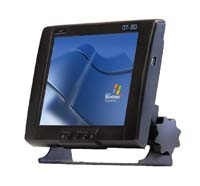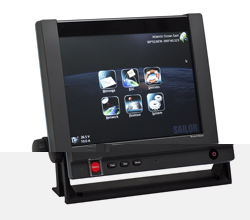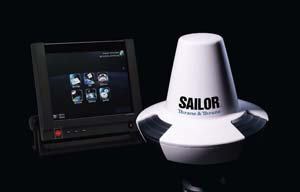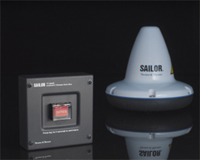Inmarsat C is a digital satellite communication system whereby anything that can be encoded into digital format, whether text, numeric data from instruments or other information in digital form, can be sent and received over the system.
The Inmarsat C system is known as store-and-forward messaging system. When sending a ship-to-shore message, it is edited on the terminal and then transmitted in a series of data packets to an Inmarsat C land earth station (LES).
The LES acts as an interface (or gateway) between the satellite and the terrestrial telecommunications network. If the LES receives any data packet in error, it signals back to the terminal to re-transmit those packets and the procedure repeats until the LES has received the complete message with no errors.
The LES stores the data packets, assemblies them into a single message and forwards it (hence the term store-and-forwarding) over the telecommunication network to its addressed destination.
Inmarsat C and Mini C mobile terminals, which are used to send and receive messages, are low-cost devices and small enough to be hand-carried or fitted to any vessel, vehicle or aircraft.
Messages are transferred to and from an Inmarsat C and Mini C terminal at an information rate of 600 bps to provide robustness and reliability.
The Inmarsat C system is operational in all four Inmarsat satellite coverage ocean regions – Atlantic Ocean East and West (AOR-E, AOR-W), Indian Ocean (IOR) and Pacific Ocean (POR) – through about 40 LESs.
Inmarsat Mini C is a new family of compact mobile terminals, which support two-way store-and-forward communication via lightweight, low-cost and low-power consumption terminals.
Depending on the model, Inmarsat Mini C terminals support the same communication functions as Inmarsat C terminals.
The typical Inmarsat C and Mini C terminal includes a small omni-directional antenna, transceiver (transmitter and receiver), messaging unit and power supply (may be powered from a battery only). Maritime terminals may also include a printer and distress button(s).
Some Inmarsat Mini C models are available with integrated transceiver, antenna and GPS receiver in one single unit. Both transceiver and antenna are very compact and easily installed on any size of vehicle or vessel.
The following communications services are available via the Inmarsat C:
Store-and-forward two-way data and messaging
Ship to shore: Text and data from Inmarsat C and Mini C terminals can be sent to:
- An email address
- Any telex or fax (text, one way only) number
- Any computer connected to the public telephone and data networks (PSTN and PSDN), using a telephone modem number
- Another Inmarsat C / Mini C mobile
- A Short (or Special) Access Code (SAC).
Shore to ship: Text and data can be sent via telex, email and the data and telephone (PSDN / PSTN) networks. To be able to send messages to ships, a shore-based message originator needs to be registered (to have a commercial service agreement) with an Inmarsat C service provider of their choice.
Ship to ship: Messages can also be sent in a ship-to-ship direction from one Inmarsat C / Mini C terminal to another.
Distress alerting and distress priority messaging
If a ship or a crew is in grave and imminent danger, maritime Inmarsat C and some Mini C models are used to send a distress alert by pressing a dedicated distress button. The alert contains information on the ship’s identity (Inmarsat C mobile number), ship’s position (latitude and longitude), ship’s course and speed, nature of distress, date / time when the alert was sent and time when the ship’s position was last updated.
All distress alerts are automatically routed through the addressed LES to an associated maritime rescue co-ordination centre (MRCC), which will establish communications with the ship and launch search and rescue (SAR) operation the ship may need.
Enhanced Group Calling (EGC)
The Inmarsat C system has a special capability known as Enhanced Group Call (EGC), which enables authorised information providers to broadcast messages to selected groups of ships. Reception by ships that are fitted with Inmarsat C or Mini C terminals is automatic. A special header is added by the system to the EGC message to indicate the group of mobiles or the geographical area to which the message is to be sent.
Two EGC services are available:
EGC SafetyNET – the international safety service, which allows authorised maritime safety information (MSI) providers, such as meteorological offices, hydrographic officers and MRCCs to broadcast messages to all ships in certain geographical areas.
Reception of SafetyNET messages is a mandatory function of the GMDSS equipment that is required to be carried in certain ships under the provision of the International Maritime Organisation’s Safety Of Life At Sea (Solas) convention.
EGC FleetNET – the international commercial service, which allows authorised information providers, such as commercial subscription services, shipping companies or governments to broadcast messages to selected groups of vessels, each of which has registered with the information provider and been added to a FleetNET closed group / network.
Data reporting and polling
Inmarsat C users may need to acquire information (short data reports) from vessels, or to interrogate automatic data-gathering platforms at fixed or variable intervals.
The data reporting service allows for the transmission of information, in packets of up to 32 bytes on request or at prearranged intervals from Inmarsat C or Mini C terminals, to shore-based customers.
Polling allows shore-based customers to interrogate an Inmarsat C or Mini C terminal or group of terminals by sending a special polling command. The polling command ‘instructs’ a terminal or group of terminals to send a data report immediately, start sending regular reports, change transmission schedule of reports or perform another task of the polled terminal(s).
Position reporting
Most of Inmarsat C and Mini C models are integrated with Global Navigational Satellite System (GNSS) receivers, such as GPS, to provide highly reliable, round-the-clock position information of a ship, which can be used for position reporting.
The position reporting service is based on using the data reporting and polling protocol and allows a shore-based subscriber (base station or shipping company) to request position information from a vessel, as a single report or automatic reception at fixed intervals, e.g. every six hours. A ship’s terminal can also be programmed to send regular position reports to any desired destination.
The position report includes ship’s identity, latitude, longitude, course, speed, date / time of the position report and time of the last position update.
DT-310 Computer with embedded LCD display

The device DT-310 is computer with embedded LCD display. It is intended for operation with satellite communication station INMARSAT. Also DT-310 can be used in other needs which conform to device’s specification. The device has embedded alarm unit which provides visual and sound signaling on closing/opening contacts of it’s own socket (DB-9M).
Specification:
| CPU: | Vortex86DX 800 MHz |
| RAM: | 256 Mb (DDR-II SDRAM) |
| SSD: | 2 Gb (UDMA-100) |
| Supported OS: | Windows 95/98/2000/XP, MS-DOS/FreeDOS, QNX, Linux |
| Display: | 10.4″ 800×600 |
| Contrast ratio: | 300:1 |
| Luminocity: | 350 cd/m2 |
| Viewable angles: | 140° |
| Response time: | 30 ms |
| Input/Output interfaces: | 2 × RS-232 (DB-9M) 1 × LPT (DB-25F) 1 × USB (Type A) 2 × PS/2 (keyboard and mouse) 1 × DB-15F (power supply) 1 × DB-9M (alarm input) |
| Power voltage: | 10…36 VDC |
| Power consumption: | no more than 40 W |
Sailor 6006 Message Terminal

The SAILOR 6006 Message Terminal stands out as the world’s first touch-screen, Wheelmarked terminal. It enables the safe operation of a vessel’s IMO GMDSS safety systems either when connected to the SAILOR 6110 mini-C or when operating in conjunction with the MF/HF installation to provide seamless radiotelex communications.
Features include:
- High contrast touch-screen display with dimming
- Perfect night and day vision
- SD card and USB support
- Integrated GMDSS distress button
- Easy-to-use icon based interface
- ThraneLINK
A number of sub-systems, such as alarm panels can be connected using RJ45 Ethernet cables via the SAILOR 6197 Switch, making installation of the SAILOR 6006 Message Terminal easier and less costly. Additional cost-saving features include a revolutionary approach to cabling with the use of NMEA 2000 style cables and connectors, and the ability to present GMDSS system battery data, therefore removing the need for a battery panel, provided that the SAILOR 6081 Power Supply and Charger is used.
The SAILOR 6006 Message Terminal features a high resolution 800×600 touch-screen that offers clear benefits to safety and operational efficiency, as it enables the user to quickly and easily carry out GMDSS and communication tasks, therefore leaving more time for other critical jobs on board. Even when using the keyboard and mouse input method, controlling the multimedia style interface, with easy-to-use, intuitive, icon based operation is very straightforward.
Specification:
| CPU: | Intel Atom based CPU (1,1 GhZ) |
| Memory: | 1 GB |
| Internal storage: | 1 GB Flash for OS and application software |
| Additional storage media: | SD card slot (SDHC) |
| Interfaces: | 5 x USB Host interface ports (all up to 480 MB) Ethernet (10/100Mbit), RJ45 RS232, DB9 male Isolated CAN-bus interface NMEA 0183 compatible talker, reference to chassis (secondary gnd) NMEA 0183 compatible listener, isolated, 4800 Baud max. NMEA 0183 compatible listener, isolated, 4800/38400 Baud max. One digital input pin for simple active/inactive detection |
| IP protection class: | IP30 on the rear section IP33 on the front surface. |
| Ambient temperature: Operating Storage |
-25°C to 55°C -40°C to 80°C |
| Power supply: | 10.8 to 32 V DC, with “remote on/off” and “on/off control output |
| Power Consumption: | Max. 20 W, typical 12 W |
| Dimensions: | 258.8 ° 299.6 ° 92.3 mm |
| Weight: | 2.0 Kg |
Sailor 6110 mini-C GMDSS

The SAILOR 6110 mini-C is a true next generation GMDSS solution. Building on the strong foundation of previous SAILOR GMDSS products, it introduces innovative new features and functionality, including touch screen operation through the cutting-edge SAILOR 6006 Message Terminal and an all new approach to installation and networking.
The SAILOR 6110 mini-C is more than just a way to meet mandatory GMDSS requirements, because as part of the innovative SAILOR 6000 Series, it is an integral part of a vessel’s communication system. The mini-C system features true triple functionality as it safely handles all GMDSS, SSAS and LRIT operation on board.
- First ever approved touch screen terminal for GMDSS use
- External storage via SD card or USB disk
- Innovative approach to cabling for simple networking and expansion
- Accurate, reliable 50 channel GPS module that is also Galileo ready
- ThraneLINK
A brand new terminal platform, the SAILOR 3027 mini-C, improves on the already de facto industry standard of the SAILOR 3026 mini-C platform, and has been introduced for the SAILOR 6110 mini-C GMDSS. During the design process, many lessons learned from the SAILOR 3026 mini-C has been incorporated. As with the previous generation SSAS functionality is available as an option.
The unique use of CAN-BUS (NMEA 2000) style cabling for the SAILOR 6110 mini-C is a major innovation. It reduces installation and maintenance time and costs by offering greater flexibility and making it easier to procure cables and tailor length and connectors, to optimise routing. Additionally, sub-systems, such as alarm panels are now connected using RJ45 cables via a switch, making expanding the system easier and less costly.
The system is comprised of the following items:
SAILOR 3027C mini-C GMDSS Terminal
The next generation mini-C terminal in the long line of successful mini-C products from Thrane & Thrane.
SAILOR 6006 Message Terminal
The revolutionary touch-screen message terminal features a 10.4” high resolution screen that offers seamless interface to all functions via the icon based interface. There is both SD card and USB ports for external storage.
SAILOR 6194 Terminal Control Unit (TCU) – optional
The TCU is used in conjunction with the SSAS option as a connection point, but its functionality can be expanded at a later stage. It meets maritime standards, with easy access and connection.
SAILOR 6101 Alarm Panel
A newly designed alarm panel for the SAILOR 6000 Series with both visual and audio alarm functionality as well as EGC message status. All received Inmarsat-C alarms can be muted with a single push.
SAILOR 6103 Alarm Panel
This alarm panel has the same basic features as the SAILOR 6101 Alarm Panel but furthermore adds VHF and MF/HF distress functionality. Like on the SAILOR 6101 Alarm Panel it is possible to mute all alarms with a single push.
SAILOR 6197 Ethernet Switch
With the use of Ethernet to interconnect many new SAILOR products, the new Wheelmarked SAILOR 6197 Ethernet Switch has been added.
SAILOR 3608 Compact Printer Unit
This unit is designed to be connected to SAILOR 6006 Message Terminal to ensure that EGC and Safety messages can be printed.
Specification:
| SAILOR 3027 GMDSS Terminal | |
| Rx Frequency Band: | 1525- 1545 MHz |
| Tx Frequency Band: | 1626.5 – 1646.5 MHz |
| GPS module: | 50 channel (Galileo ready) |
| Antenna elevation: | -15° to 90° |
| G/T: | -23,7 dBk at 5 degree elevation |
| Min. EIRP: | 7 dBW at 5 degrees elevation |
| Inmarsat Protocol services: | Message transmission and reception with IA-5, ITA-2 and binary transfer to/from: • Telex PSTN (telephone modems and fax modems) • EGC message reception with automatic geographical area selection. Polling and data reporting with automatic transmission of position reports down to a recommended minimum of 1 per 5 minutes. Special Access Codes DNID Messaging Program Unreserved Data reporting |
| Receive storage: | up to 32 Kbyte |
| Global services Data: | 1200 symbols/sec BPSK |
| Data rate: | 600 bit/sec |
| Max. Transmission size: | 10 Kbyte |
| Interface: | NMEA 2000 DeviceNet Mini-style, Male |
| Power input: | 9V – 32V DC from CAN compliant power supply. 15 V DC Nominal Input Power |
| Max. Power: | 30 W |
| Max. continuous current: | 2.8 A |
| Max. peak current: | 4 A (startup) |
| Standby power, Rx mode: | < 2 W |
| Sleep Mode power: | < 10 mW |
| Compass safe distance: | 5 m |
| Weight: | 1.10 kg (without pole mount) |
| Dimensions: | Ø170.5 ×145 mm (without pole mount) |
| Water and dust: | IP66 and IP67 |
| Ambient Temperature: Operating range Storage |
-35°C to 55°C -40°C to 80°C |
SAILOR TT-3000E mini-C GMDSS

Based on a lifetime experience in maritime communication products for the GMDSS requirements, Thrane & Thrane now presents a GMDSS solution made from the 4th generation Inmarsat-C platform: The new SAILOR TT-3026C mini-C GMDSS transceiver.
The SAILOR TT-3000E mini-C GMDSS System has been developed to meet market requirements for reliable and stable communication. Whether it is an emergency that requires distress calling or messaging of ordinary commercial character, the SAILOR TT-3000E mini-C GMDSS system is your ultimate choice as a reliable satellite communication platform. The ruggedized compact design of the SAILOR TT-3026C GMDSS mini-C transceiver makes it very attractive for your new GMDSS solution. SAILOR TT-3000E is based on proven technology from the largest supplier of Inmarsat-C terminals.
Ship Security Alert System add-on
The TT-3000E mini-C GMDSS System comprises the possibility to function as Ship Security Alert System also. Based on the experiences from the well-known SAILOR TT-3000SSA Ship Security Alert System, it has been a natural evolution to develop an add-on solution for the SAILOR TT-3000E mini-C GMDSS system. The SSAS add-on kit is expected to be available from second quarter of 2006.
- Full compliance with the latest Inmarsat-C specifications for GMDSS with distress calling CN114, IEC 1097-4, IEC 945, and CE requirements
- 2-way data, fax, and e-mail transfer to destinations worldwide
- Reception of Inmarsat-C broadcasted maritime safety information (Enhanced Group Call)
- Data- and position reporting to multiple destinations and time intervals
- Flexible installation
- SSAS functionality as an upgrade solution
- Supports LocPoint Web-based tracking and SSAS management solution
The SAILOR TT-3000E mini-C GMDSS System comprises the following items:
SAILOR TT-3026C mini-C GMDSS Transceiver
Latest family member in the highly successful mini-C products from Thrane & Thrane.
SAILOR TT-3606E Message Terminal
The compact SAILOR TT-3606E Message Terminal features a 10.4″ high-resolution TFT flat panel display with an advanced light sensor to ensure clear and straightforward operation in any light conditions. The terminal features e-mail, telex, fax or data.
SAILOR TT-3616C Junction Box
Newly designed Junction Box for the SAILOR TT-3000E system. Lives up to maritime standards for easy access and reliable cable mounting.
SAILOR TT-3042C Remote Alarm / Distress Box
This unit features both visual and audio alarm functions indicating incoming EGC distress messages. The Remote Alarm increases safety at sea by enabling a distress alert to be sent from up to 3 locations on board the vessel.
SAILOR TT-3608A Compact Printer Unit
The printer unit is designed for direct connection to the SAILOR TT-3606E Message Terminal in order to ensure that all EGC and safety messages are printed without delay.
SAILOR N163S Power Supply
The universal AC/DC power supply featuring automatic change-over from AC mains to 24V DC, ensuring continued power.